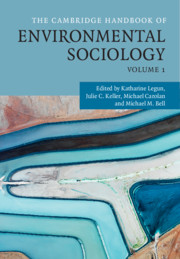Book contents
- The Cambridge Handbook of Environmental Sociology Volume 1
- The Cambridge Handbook of Environmental Sociology
- Copyright page
- Contents
- Figures
- Tables
- Contributors
- Foreword
- Introduction
- Part I Theory in Environmental Sociology
- Part II The Economy and Environmental Sociology
- Part III Culture and Environmental Sociology
- Part IV Politics, Power, State
- 17 Conflicting Environmental Imaginaries in Post-Apartheid South Africa
- 18 The Growth in International Audit Culture: Achieving Agricultural Sustainability Inside a World of Measures?
- 19 Political Ecologies of State Land Management
- 20 Green Crime and the Treadmill of Production
- 21 Governing Science and Technology: From the Linear Model to Responsible Research and Innovation
- 22 The Paradox of Public Knowledge in Environmental Sociology
- 23 Relational Resilience and the Making of Diverse Worlds
- Part V Social Justice
- Index
- References
21 - Governing Science and Technology: From the Linear Model to Responsible Research and Innovation
from Part IV - Politics, Power, State
Published online by Cambridge University Press: 05 November 2020
- The Cambridge Handbook of Environmental Sociology Volume 1
- The Cambridge Handbook of Environmental Sociology
- Copyright page
- Contents
- Figures
- Tables
- Contributors
- Foreword
- Introduction
- Part I Theory in Environmental Sociology
- Part II The Economy and Environmental Sociology
- Part III Culture and Environmental Sociology
- Part IV Politics, Power, State
- 17 Conflicting Environmental Imaginaries in Post-Apartheid South Africa
- 18 The Growth in International Audit Culture: Achieving Agricultural Sustainability Inside a World of Measures?
- 19 Political Ecologies of State Land Management
- 20 Green Crime and the Treadmill of Production
- 21 Governing Science and Technology: From the Linear Model to Responsible Research and Innovation
- 22 The Paradox of Public Knowledge in Environmental Sociology
- 23 Relational Resilience and the Making of Diverse Worlds
- Part V Social Justice
- Index
- References
Summary
Two decades ago, John Urry and I outlined a tentative agenda for the sociology of the environment. Science was seen as implicated not simply as a central and necessary authority in providing solutions to our most perilous environmental problems but also in contributing to those same problems. Yet, what we underestimated at the time was the critical role of governance in science and technology and its role in modulating environment-society relations. For if we are to understand the differential contribution of science and technology to environmental change, we need to understand better the impact of traditional forms of science governance and the potentials of alternative configurations. In this chapter I discuss four paradigms through which science and technology have been governed, situating each in historical context. Starting with the ubiquitous ‘linear model of innovation’ I locate its origins and provenance, how it came to be replaced, at least in part, through a ‘grand challenges’ paradigm of science policy and funding, how this paradigm in turn has been subjected to rigorous analytical critique by a co-production model of science and society, and how this model, in part, is being put into practice through a framework of responsible research and innovation.
Keywords
- Type
- Chapter
- Information
- The Cambridge Handbook of Environmental Sociology , pp. 347 - 361Publisher: Cambridge University PressPrint publication year: 2020
References
- 1
- Cited by

